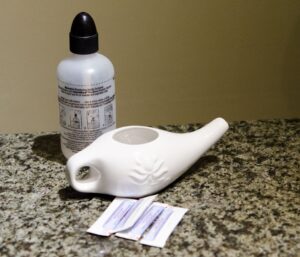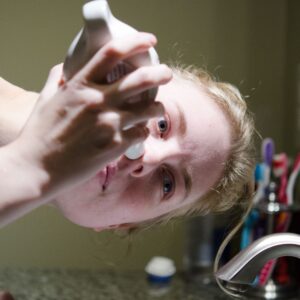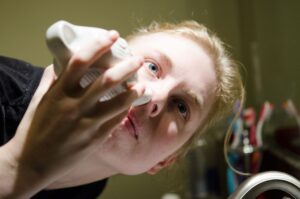The neti pot. Unsettling in theory, but very useful and effective in practice. Want to know why you might want to use a neti pot? How to use it? Some tips and tricks to make it more effective? Read on.
 What is a neti pot?
What is a neti pot?
A neti pot is a container into which you put salt water for rinsing out your nasal passages and sinuses. This can take the form of an Arabian-lamp-style shape (I use this one), a teapot shape, a squeeze bottle, or a pulsing electronic pump. Although there are different names for each, the concept is the same; running water through your sinuses.
Why might I want to use a neti pot?
Most people are introduced to neti pots by their doctor, who suggests they use it to help with sinus allergies. My ear nose and throat specialist didn’t really tell me much more than that. Here’s what sinus rinsing can do:
- Reduce sinus allergy symptoms by rinsing allergen particles out of the nose before your body has a chance to react to them, or so that your body doesn’t continue to react to them. A single strong exposure can leave me feeling flu-like just from sinus allergies. The neti pot halts my allergic reaction and allows things to start getting better.
- Reduce mucous buildup in the nose to help you breathe better, either because of previous allergic reaction or because of a cold. I actually find I recover from colds in less than half the time as compared to my family when I use the neti pot to rinse my sinuses.
- Reduce the incidence of colds as a whole (my experience, not medically proven), as well as sinus infections. My doctor even recommends sinus rinsing as a first line of treatment when I have a sinus infection, only prescribing antibiotics if I get really ill.
I use the saline sprays. Those will work just as well, right?
Saline sprays are okay, but they tend to have a much higher salt concentration, irritating the mucosal passages of the nose and causing more mucous to form. They are, however, very convenient for short-term travel. The biggest reasons why I don’t use a saline spray anymore are volume and reach. A single saline spray bottle contains somewhere from 100 to 500 mL of saline solution, and costs $6 to $20. You use a squirt or short stream of this in each nostril, usually while upright. A neti pot, by comparison, holds about 230 mL which you use in one single session, and each rinse costs about 20 cents (or less, plus water). You run the entire contents through not just your most immediate nasal passages but also your sinuses. Which one do you think will give you the most thorough rinse? A bottle of saline spray may last a little while, but you are using less solution to get a less thorough rinse.
How do I use a neti pot?
 Neti pots may take a little while to master, but you should be able to use one pretty competently with a couple of practices. Firstly, it is important to understand the concept of the sinus rinse. The water enters one nostril, flows through the sinuses to the other side, and exits the other nostril. When done correctly, it does not enter the mouth, unless the sinuses are extremely clogged, as during a severe cold. Your sinuses are also connected to your inner ear for drainage of your ears, a connection that can work in reverse if care is not taken, or when sinuses are congested.
Neti pots may take a little while to master, but you should be able to use one pretty competently with a couple of practices. Firstly, it is important to understand the concept of the sinus rinse. The water enters one nostril, flows through the sinuses to the other side, and exits the other nostril. When done correctly, it does not enter the mouth, unless the sinuses are extremely clogged, as during a severe cold. Your sinuses are also connected to your inner ear for drainage of your ears, a connection that can work in reverse if care is not taken, or when sinuses are congested.
- If you have long hair, pull it back, away from your face.
- Make the saline solution – Empty a packet of salt mix into the neti pot or bottle. The salt packets are pre-measured and sterile. If the container has a lid, fill up to the line with sterile water, put the lid on, cover the holes, and shake until mixed. If the neti pot does not have a lid, add a little less than one centimeter (1 cm) of water to the bottom and then swirl the pot until all of the salt crystals dissolve. After the mix has dissolved, add the remaining water to fill. Some neti pots come with separate mixing containers, in which case you can use that.
- Blow your nose to clear any loose mucous. This will make the rinse more effective.
- Begin to rinse – Lean forward over a sink and tilt your head to one side. Push the back of your tongue up against the back roof of your mouth. This is what will keep the saline rinse from running down your throat, and may take a bit of practice. Hold the neti pot or bottle with the same hand as the nostril that is upwards, and place its opening against the nostril. Tip the pot or squeeze the bottle slightly, until a gentle stream of water exits the lower nostril. Rinse for a few seconds (up to 10 or 20 seconds, if desired), then put down the bottle or pot.
- Clear mucous – Tip your head to the other side, so that the nostril where the water entered is now on the bottom. Blow your nose gently to eject the solution from your nose and sinuses. If desired, you can block the lower nostril while you blow. I find that the combination of the head tipping and nostril coverage reduces the incidence of solution remaining in the passages leading to the ear canals.
- Rinse the other side by repeating steps 3 and 4 on the other side.
- Continue to rinse until you are comfortable that your sinuses are clear or until the neti pot or bottle is empty.
Advanced instructions: To better access the lower and upper sinuses, think about nodding. While the head must remain tilted to one side or the other, the head can nod all the way forward, tipping the upper sinus down further and allowing easier clearing. If the head nods up/back, bringing the forehead up and the chin forward, better access to the lower sinuses is obtained. Be aware that when accessing the lower sinuses the solution may run out of the lower sinus and down the face to the chin. Although this may be an unappealing outcome, it is easy to rinse or wash the face after the sinus rinse is done, and it’s preferable to a sinus infection.
ADDED: Another trick that I use is to do little half air-swallows, like you do when flying, to equalize the air pressure. This will create a bit of a vacuum to help pull the solution further into your nasal passages.
- Upper Sinus
- Lower Sinus
What else do I need to know?
- Always use sterile water in a neti pot. I used to boil my water and let it cool before use; now I use distilled water. There are instances where bacteria and viruses in tap water have caused the death of individuals in North America. Because you are putting the solution into an area where contaminants can easily migrate towards the brain, using the purest solution you can is a no-brainer.
- While plastic pots and squeeze bottles can be sterilized in boiling water or in the microwave according to the manufacturer’s instructions, they have a finite shelf life, which in one major brand is three months. If you are going to be using this long term, save yourself some money (and possible plastic contamination) by buying a glazed, ceramic neti pot. Ceramic pots can and should also be sterilized regularly, but will last for years.
- Don’t rinse right before bedtime. After rinsing, some of the water is left behind, and continues to keep your mucous looser for a few hours afterward. If you lay down right after rinsing, that mucous can migrate to your ear canals and deeper into your sinuses. Staying upright for a couple of hours after rinsing is best. I find the best times to rinse are when getting ready in the morning and just before suppertime.
- Rinse no more than twice a day. If you rinse more than that, your nasal passages and sinuses can become dry and irritated, possibly producing more mucous. I find that for maintenance care once per day is sufficient.
Do you have any questions about neti pot use? Want to share your story? Comment below.


